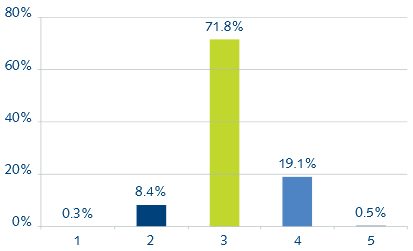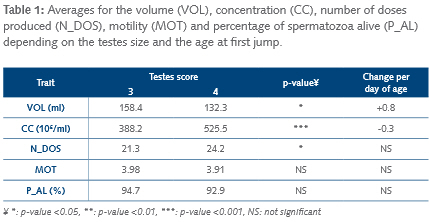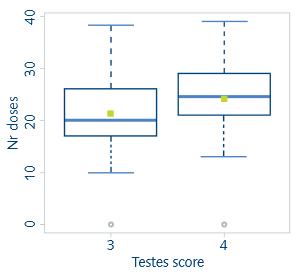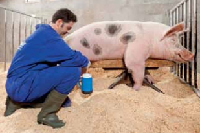



Testes Size as Predictor for Semen Production and Relation to Female Reproductive Traits
Hypor tested testes size and results showed that boars with bigger testes produce semen with a higher concentration of spermatozoa than boars with smaller testes and, therefore producing more doses, although the volume produced is reduced, according to Florence Ytournel, European Geneticist with Hypor. In addition, she found, positive correlation to female reproductive traits, such as total piglets born and percentage of piglets born alive, have been found in boars with larger testes.
Abstract
Semen production is an important parameter to AI studs in the pig industry. This parameter can only be evaluated once the boar has entered quarantine and semen has been collected. Therefore, a protocol to visually score the testes size of the boars was developed.
Hypor has evaluated these subjective scores of testes size as a predictor of semen production and how it relates to female reproduction traits.
Results show that boars with bigger testes produce semen with a higher concentration of spermatozoa than boars with smaller testes and thus more doses although the volume produced is reduced. Moreover, positive correlations to female reproductive capacity were found.
Introduction
Semen production is a crucial part in the pig industry. However, the related traits (volume collected, concentration and quality of the semen or number of doses produced by jump) can only be collected after the decision of using the boar and having entered him at least in quarantine. Poor production and/or quality of semen can lead to slaughter of the boars and undesired costs. It would thus be interesting to have an early predictor of the semen production capability of the boar before it enters quarantine.
Testes size has been shown to be a good predictor of semen production (Rathje et al (1995); Huang and Johnson (1996)). This trait has a moderate to high heritability (0.12 to 0.80, Bidanel (2011)), indicating the possibility of efficient selection. According to literature, testes size (width, length or weight) is negatively related with the volume produced but positively related with the concentration produced.
Weighing the testes or measuring them with a ruler is not practically feasible. Therefore we decided to score testes size on a scale from 1 (very small testes) to 5 (very big testes). To achieve the best results possible, the technician has to score the testes independent of the body size of the boar, as bigger hams will provide the impression of smaller testes. The first question that had to be answered was to know if a sufficient variability could be found in the scores to allow further developments towards selection. Selection only works when there is variation. The distribution of the 2,510 first scores (Figure 1) shows a spread of the scores; this opened the door for further research.

Data provided by our European AI stud were used to confirm that the relations found in the literature also apply here. Data from 21 boars were included. From these boars, 13 boars had a score of 3 and 8 boars had a score of 4. A statistical analysis was conducted to evaluate the relation between the testes size and five production traits:
- volume (ml) (VOL)
- concentration (106 spermatozoa/ml) (CC)
- number of doses produced (N_DOS)
- percentage alive (P_AL) and
- motility (scored from 1 to 5) (MOT)
As we are interested in a predictor for early production of semen, only the production results of the first eight jumps of these boars were included.
The effect of the interval between two jumps was tested for all traits but proved to be not significant. On the other hand, the age at first jump showed a significant favorable effect on the volume produced – +0.8 (or 0.027 oz) ml per day of age – but a significant unfavorable effect on the concentration of the semen produced – -0.3 (or 0.01 oz) million spermatozoa per ml per day of age (Table 1).

This analysis confirmed that boars with smaller testicles produce a higher volume of semen with a lower concentration than boars with bigger testes. The increased volume does not compensate for the concentration and thus boars with smaller testes will produce fewer doses. No statistical difference could be found between the two groups in the quality traits of the semen.
Further investigation on the variability of the production traits indicated that the variance in the number of doses produced will stay similar, however with a higher average number of doses produced (Figure 2). Selecting on testes size would be profitable from a production point of view, without being at the expense of increasing the risk of having some less productive boars.

The green points represent the average, the extreme horizontal lines delimit the region containing 95% of the records.
A final point to be evaluated was to check that bigger testes are genetically linked to favourable reproduction results in the females, i.e. do the female relatives of the boars with the bigger testes also produce larger litters?
To assess the genetic link between the scores on testes size, we included the scores of the 2,510 boars evaluated and the farrowing results (total number of piglets born, percentage of piglets born alive and percentage of piglets weaned) of 4,866 farrowings from 1,244 sows.
The estimated heritability of testes size was 0.20. This estimate is in the range found in literature (Bidanel (2011).

Genetic correlations between testes size and the female reproductive traits were estimated to be positive and significantly different from 0 for total number of piglets born and the percentage of piglets born alive. The correlation with the number of piglets weaned was slightly negative but statistically not different from 0.
There are very few articles on the genetic relation between the testes size and the reproductive results of the females. Nevertheless, the positive correlation between NBP and testes size is in accordance with the results of Smital et al. (2005).
Conclusion
Size matters! Size of testes in boars is related to the semen production.
The visual evaluation of testicle size appears to be a good predictor to select boars with a higher semen production capacity.
Positive genetic correlations were found with total number of piglets born and the percentage of piglets born alive, providing a first insight into a possibility of indirect early selection for female traits on the boar side.
Co-authors of this paper are E. Brunet (France Genes), P. Derks (Hypor) and A. Huisman (Hypor).
July 2014








